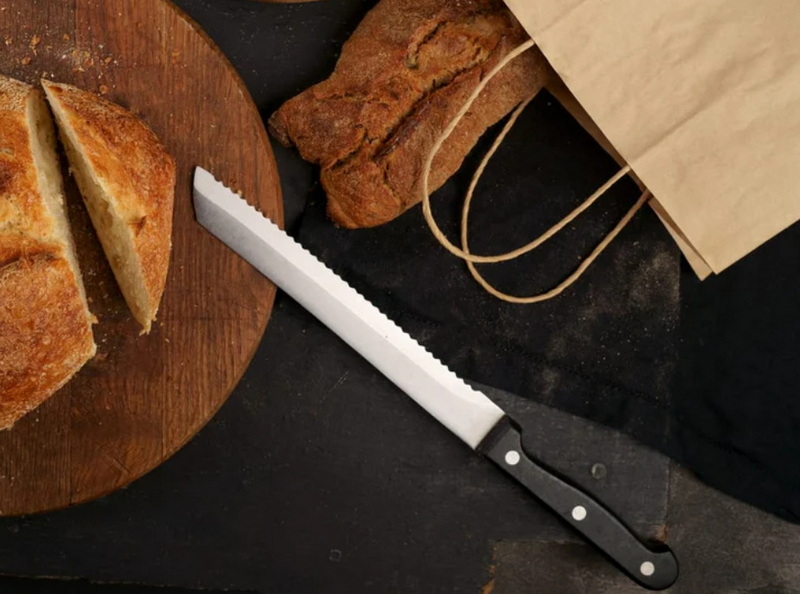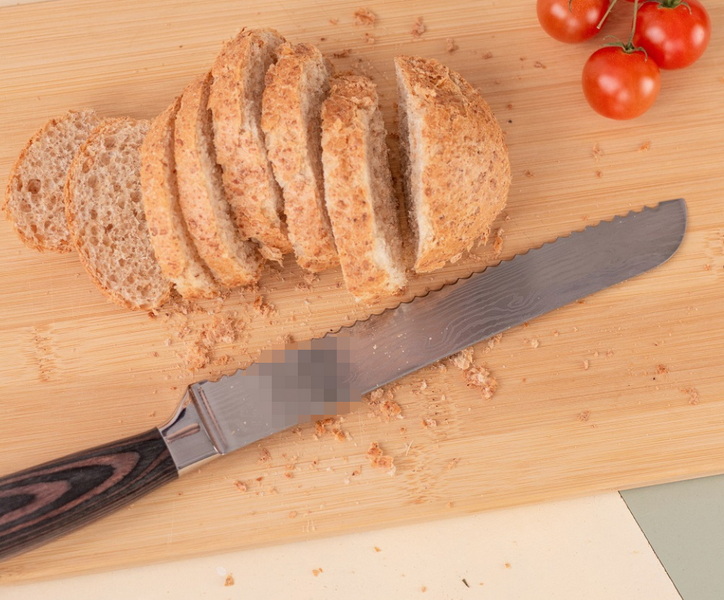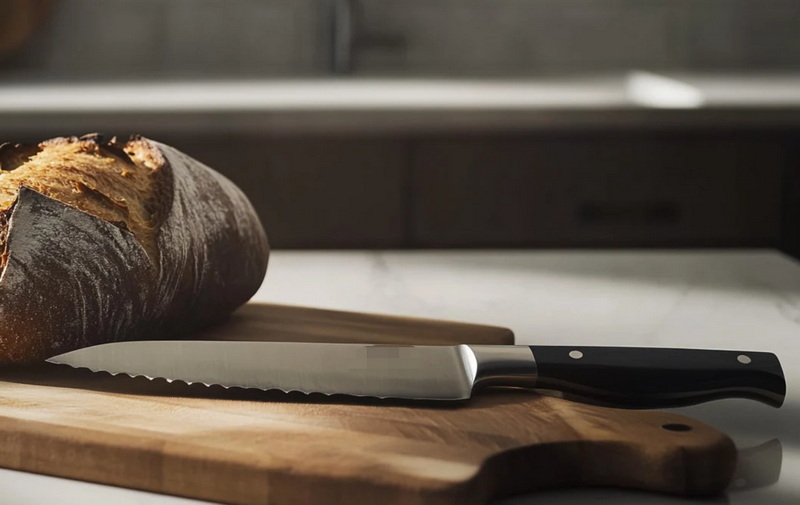- All
- Product Name
- Product Keyword
- Product Model
- Product Summary
- Product Description
- Multi Field Search
Views: 222 Author: Ann Publish Time: 2025-11-06 Origin: Site











Content Menu
● 1: Anatomy and engineering of the Bread Knife
● 2: Bread Knife beyond bread: primary culinary applications
● 3: Material science and product variants for OEM partnerships
● 4: Design considerations for marketing, packaging, and education
● 5: Techniques for effective use and care
● 6: Practical OEM and market-ready messaging
● 7: Content ideas for your promotional content
● FAQs
>> Can a Bread Knife cut tomatoes without crushing them?
>> Is a Bread Knife suitable for pastries and cakes?
>> Can it be used to portion cooked meats?
>> What materials make a durable Bread Knife?
>> How should Bread Knives be maintained?
The Bread Knife is a staple in professional kitchens and home drawers alike, renowned for its long serrated blade that cleanly severs crusty exteriors while preserving tender inner crumb. Yet the Bread Knife's true value extends far beyond slicing bread. For OEM manufacturers, brand marketers, and international buyers, understanding the Bread Knife's versatility unlocks a broader product narrative, enabling cross-category marketing, compelling educational content, and stronger value propositions. This long-form guide explores the Bread Knife's wide range of uses, supported by material science, ergonomic design, maintenance tips, and practical tips tailored for foreign brands, wholesalers, and manufacturers serving oil and gas-adjacent sectors where robust kitchen tools are part of supplier portfolios and hospitality workflows.

- Blade geometry and serration: A typical Bread Knife features a long blade with a serrated edge whose teeth grip and saw through crusts with minimal downward pressure. This geometry reduces crumb compression and prevents tearing, enabling consistent slices from crusty baguettes to soft sandwich loaves. For OEM buyers, this is a core selling point: edge geometry translates to reliable performance in diverse markets with varying humidity and bread textures.
- Blade material and heat treatment: High-carbon stainless steels (e.g., 58–60 HRC ranges) offer a balance of hardness, edge retention, and corrosion resistance, which matters across regions with different water qualities and dishwasher practices. Consider offering alloy variants or customized heat-treat profiles to meet regional expectations for sharpness longevity and rust resistance.
- Handle design and balance: The Bread Knife's handle ergonomics, tang integration, and balance significantly affect fatigue during prolonged food prep. An ergonomic, non-slip handle reduces wrist strain during repetitive slicing tasks, a critical factor for professional kitchens and catering operations. For OEM collaborations, presenting multiple handle materials (e.g., pakkawood, G10, durable polymers) and spreads of balance options can broaden market fit.
- Slicing crusty breads and buns: The Bread Knife's primary duty is to slice crusty loaves with clean crumb. The serrations enable a gentle sawing action that prevents crushing, yielding uniform slices essential for sandwiches and precise portioning in bakeries.
- Pastries and cakes: Flaky pastries, brioche, croissants, pies, and layered cakes benefit from the Bread Knife's ability to cut through delicate layers without deflating or tearing. For patisserie applications, the knife offers predictable slice thickness, enabling consistent portion control and presentation.
- Tomatoes, melons, and soft fruits: The bread knife excels at tomatoes, citrus, and other fruits with tough skins or membranes. Serrated edges pierce skins without crushing, preserving the fruit's structure for salads, charcuterie boards, and plating. In product photography, this capability translates into visually appealing textures.
- Cheese and confectionery: Semi-soft cheeses and firm confections with delicate interiors can be portioned with minimal crumbling when a Bread Knife is used with a light, steady sawing action. In marketing materials, emphasize versatility across dairy and confectionery contexts to expand category appeal.
- Roasts and cooked meats: While specialized carving knives optimize precision, a Bread Knife can portion roasted meats or poultry after cooking, especially for buffet lines or catered events where equipment variety may be limited. This showcases the knife's adaptability as a secondary tool in professional kitchens.
- Non-culinary uses in a professional context: In some settings, serrated blades are used for tasks such as crust removal from baked goods, or for opening packaging where a rough serration is beneficial. When communicating to OEM clients, frame these uses as occasional rather than primary tasks, with proper safety guidance.
- Steel grades and edge retention: Offering a menu of blade alloys allows buyers to tailor products to climate and user demands. For example, premium stainless variants with higher corrosion resistance suit coastal markets, while reinforced edge geometry suits high-volume kitchens.
- Serration styles and counts: Different serration patterns (coarse vs fine, variable tooth spacing) impact performance on various textures. Providing options or modular serration kits can help partners adapt to regional bread types and culinary practices.
- Handle ergonomics and customization: Beyond color and material, consider customizable tang shapes, bolster designs, and grip textures. Custom branding on the handle (laser etching, logo engraving) adds value for OEM clients seeking differentiation.
- Coatings and maintenance features: Optional non-stick or easy-clean coatings can improve user experience and cleaning efficiency, a valuable selling point in regions with stringent hygiene requirements. Expanded accessory lines such as sheathes, edge guards, and maintenance kits can be bundled to enhance perceived value.
- Educational content: Create usage guides, care instructions, and recipe cards that accompany the product. Multilingual captions and subtitles for demonstration videos improve accessibility for global markets.
- Packaging with value-adds: Consider packaging that communicates versatility beyond bread, such as labeled sections for pastries, fruits, and meats, or including a small care card detailing sharpening and storage practices.
- Compliance and labeling: Ensure packaging and manuals comply with destination market regulations, including material disclosures, safety warnings, and warranty terms to streamline entry into North American, European, and Asian markets.
- Slicing technique: Use a controlled, gentle sawing motion without applying excessive downward pressure. Let the serrations do the work to maintain crumb structure and slice uniformity.
- Food support and stability: Place the item on a non-slip board or dampen the surface to prevent sliding during cutting, particularly for bread with soft or crumbly interiors.
- Blade protection and care: Hand-washing preserves blade edge life and minimizes corrosion risk; dry promptly and store in a protective sheath or knife block. Regular honing or periodic sharpening maintains optimal performance for extended lifespans.
- Seasonal and market-driven usage demonstrations: Produce seasonal video tutorials (e.g., summer fruit slicing, autumn bread textures) to resonate with regional consumer habits and culinary calendars.

- Core value propositions: Emphasize durability, edge retention, ergonomic design, and versatility beyond bread in marketing materials, catalogs, and websites to appeal to professional kitchens, hospitality buyers, and home cooks.
- Regional localization: Localize copy to reflect bread varieties and culinary practices in target markets. For instance, emphasize crust types common in European bakeries or Asian bakery textures when appropriate.
- After-sales support: Provide maintenance guides, spare parts availability (replacement blades, handles), and warranty policies that reassure international customers about long-term investment value.
- Recipe and usage guides: Publish simple recipes that illustrate using a Bread Knife for delicate slicing (e.g., croissant portioning) to demonstrate practical versatility.
- Customer case studies: Document how OEM clients integrated Bread Knife lines into their product portfolios to meet market demand, including metrics like reduced waste and improved customer satisfaction.
A Bread Knife is more than a singular bread-slicing tool; it represents a versatile, efficiency-enhancing instrument that can support a broad range of culinary tasks across professional kitchens and consumer use. For OEM partners and international brands, presenting the Bread Knife as a multi-use asset—backed by thoughtful material choices, ergonomic design, robust care guidance, and rich educational content—creates a compelling value proposition. By leveraging high-quality imagery, well-produced demonstration videos, and localized messaging, brands can elevate the Bread Knife's profile within a product portfolio and in global markets, turning a familiar tool into a trusted workhorse for cooks, bakers, and gastronomes alike.

A: Yes. The serrated edge grips and pierces the skin, allowing clean, intact slices with minimal pressure on the flesh.
A: Absolutely. It handles flaky pastry, laminated doughs, and layered cakes with minimal compression, preserving presentation.
A: It can portion cooked roasts and poultry, particularly when a carving knife is unavailable; for precise carving, a dedicated carving knife is preferred.
A: High-carbon stainless steel blades with ergonomic handles, supported by corrosion-resistant coatings and secure tang design, offer longevity and comfort.
A: Hand wash, dry promptly, and hone or sharpen as needed to maintain edge life. Store safely in a knife block or sheath.
The Ultimate Professional Knives for Halal Butchery in Middle Eastern Kitchens
Chef Knife Size Guide: Choosing Between 6″, 8″, 10″, And 12″
Custom Knife Handles: How To Design A Chef Knife That Fits Your Hand Perfectly
Chef Knife Surface Treatments Guide: From Polished Migaki To Damascus Patterns
Inside Our Professional Knife Sample Room: Quality You Can See
Universal Knife Block Buying Guide: Modern Acrylic & ABS Knife Holders for Professional Kitchens
Universal Knife Block: The Complete Guide To Modern, Hygienic Knife Storage
The Complete Guide To Red Handle Knife Sets: Style Meets Functionality in The Kitchen
Professional Knives for Halal Butchery And Middle Eastern Cuisine